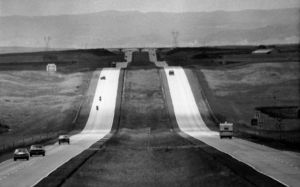
When I turned 16 back in the late 60’s everyone went to get their driver’s license immediately. We didn’t even have to have taken and passed Driver’s Education then. Just show up and take the test and hope you passed, as I did. It was status then and a right of passage.
As the following article delineates, once again we’re seeing a fundamental change in our culture. The younger generation has many different values and perspectives than we did and do. And in regard to how they view theauto-centric lifestyle, I think it’s great for so many reasons not the least of which is that it is healthier for them personally in so far as they will walk and bike more. But also in regards to public health with less pollutants being emitted from both the vehicles themselves but also in the manufacturing process.
Americans and their cars: A love affair on fumes?
By ADAM GELLER, AP National Writer
Updated 11:57 pm, Saturday, May 31, 2014
1 of 20
FILE – In this Sept. 8, 1972 file photo, cars pass by on Interstate 90, into the Black Hills in Murdo, S.D. After rising continuously since World War II, driving by American households has declined nearly 10 percent since 2004. Photo: Uncredited,
The couple in the convertible sail down a pristine freeway, the pavement theirs alone. At the wheel, he smiles in suit and tie, while she leans closer, every blonde hair in place, her face a portrait of mobile bliss.
“To whirl along with all the joy your car has to offer,” reads the ad. “That’s something to want.”
When it ran in the Saturday Evening Post in 1955 — bought by a steel company to hail the newly proposed interstate highway system — U.S. car culture was kicking into top gear. Americans embraced driving as the quickest route to independence, convenience and opportunity and cars as extensions of our homes and our personalities.
But six decades later, take a moment the next time you’re stuck in traffic to consider where we’re headed. America’s romance with the road may be fading.
After rising almost continuously since World War II, driving by American households has declined nearly 10 percent since 2004, a drop whose start before the Great Recession suggests economics may not be the only cause.
“There’s something more fundamental going on,” says Michael Sivak, a researcher at the University of Michigan Transportation Research Institute.
The average American household now owns fewer than two cars, returning to the levels of the early 1990s.
More teens are waiting to get a license — or not getting one at all. Less than 70 percent of 19-year-olds now have one, down from 87 percent two decades ago, government figures show.
“I sort of marvel at this … especially with my students. They’re just not into cars even in the same way my generation was and I’m 45,” says Cotten Seiler, author of “Republic of Drivers: A Cultural History of Automobility in America,” and a professor at Pennsylvania’s Dickinson College. “I wonder if they’ve decided that there’s another, better way to be free and to be mobile.”
Our changing relationship with cars and driving isn’t always obvious. But it becomes clearer on the road, where a journey through five states and across more than 900 miles reveals shifts in habits and attitudes. At a high school in Oshkosh, Wisconsin, you’ll notice that the parking lot remains half-empty even after students with cars return from lunch. In conversation at a Minneapolis coffee shop, customers tell of hours spent pecking away in place thanks to Wi-Fi, rather than driving to work.
And those changes — whether its car trips replaced by shopping and socializing online, or jams that have turned drives from an escape into a chore — raise complicated questions.
For much of the last century, the car has been Americans’ primary vehicle for realizing individual freedom. But in an era of road rage, gas close to $4 a gallon and the temptation of texting behind the wheel, is driving still a love affair? Or is it just a way to get from here to there?
___
At 6:45 a.m., Sam Kirstein pulls into central Minneapolis after a 5-mile commute, parks and locks his vehicle — and heads for a hot shower.
You wouldn’t know when he takes a seat minutes later, wearing a pressed striped dress shirt, that he arrived on two wheels.
Kirstein, an accountant, recalls growing up in a small town in South Dakota where “cars were a way of life.” In Minneapolis, he drove 45 minutes to work in traffic, until he and his wife wearied and set off to bike cross-country. They returned, but never put away the bikes. Last year, Kirstein cycled to work every day but five, and put 4,000 miles on a car that used to clock 15,000.
“The only thing I miss is being able to listen to the radio,” says Kirstein, 45, nursing a mug of coffee at Freewheel Bike — sort of a rest stop for cyclists with lockers, bike parking and a cafe — before heading up to the office.
Each day, more than 3,500 others share Kirstein’s route on the Midtown Greenway, a freight rail bed converted to bike highway. More than 4 percent of Minneapolis commutes now happen on a bike, doubling since 2000. Despite bitter winters, more are testing the idea of leaving cars behind.
1 |2 |3 |4 |5Next »


